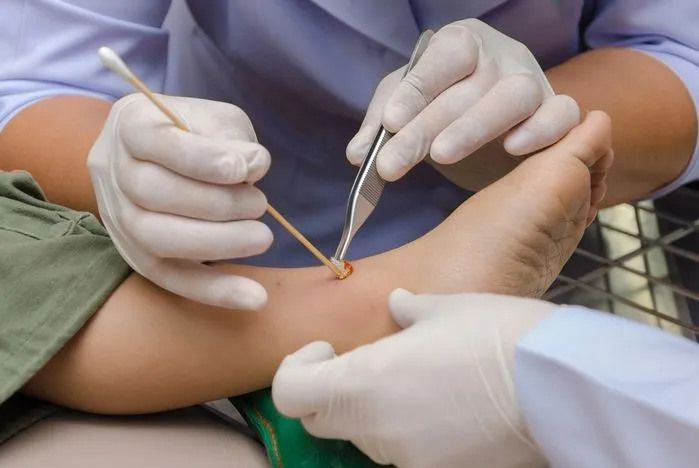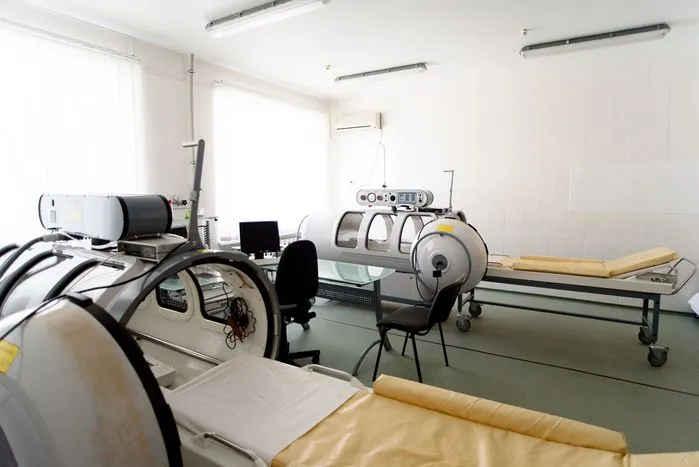Iodoform gauze packing strips, versatile as a multi-tool, are incredibly handy in wound treatment. Crafted with iodine, carbon, and hydrogen, these strips offer both antiseptic benefits and a gentle anesthetic effect. By merging this with the absorbent, light nature of gauze, you get an effective solution for wound care. These strips shine in their ability to strike a moisture balance conducive to healing, manage wound discharge, and fill hard-to-reach, deep wounds. Like every tool, there are potential drawbacks - infection risks or allergic reactions to iodine are a possibility.
Key Takeaways
- It merges absorbency with antiseptic properties, creating an effective solution for wound dressing.
- They not only absorb excess fluids but also balance moisture levels, aiding in wound healing while preventing infections.
- For application, ensure thorough cleaning of the wound before gently packing the cavity with the gauze.
- Avoid over-packing and ensure a change every 24 to 48 hours. Even with antiseptic properties, clean treatment of the wound is necessary to reduce infection risks.
- Iodoform gauze strips are superior to other dressings due to their unique antimicrobial abilities, making them especially beneficial for deep or tunneling wounds.
Understanding Iodoform Gauze Strips
Iodoform gauze strips, though seemingly simple, play an indispensable role in medical wound management. Their iodoform component acts as a powerful antiseptic, creating an effective barrier against harmful pathogens.
Composed of iodine, carbon, and hydrogen, iodoform is a yellowish crystalline organic compound. Apart from its strong antibacterial function, this compound also boasts mild anesthetic properties that numb the affected area, providing relief.
Gauze, a thin, translucent fabric with a loose open weave, complements the iodoform in these strips. Its high absorbency efficiently manages exudates, while its non-stick surface minimizes pain during dressing changes.
"Transform Wound Care with Iodoform Gauze Packing Strips – Combining the power of antiseptic action, moisture balance, and absorbency, these strips are your go-to solution for effective healing, especially in deep or tunneling wounds. Use with care, and experience the innovation in wound management today!"
Importance in Wound Healing
Uniquely, they manage moisture effectively, creating an environment conducive to healing. Excessive moisture can result in skin softening, known as maceration, which can postpone healing. Conversely, insufficient moisture can stimulate scab formation, obstructing the growth of new tissue. However, they maintain the right moisture balance, absorbing excess exudate to facilitate optimal healing conditions.
They also possess remarkable infection control properties by eliminating bacteria upon contact and effectively preventing infections from establishing in wounds.
Usage and Application
Significant wound healing progress depends on the correct application and usage of iodoform gauze strips. Infused with antiseptic properties, this gauze type helps promote recovery and infection prevention when properly packed into wounds.
Applying these strips correctly is essential for successful recovery. Initially, cleanse the wound before introducing gauze gently into its cavity. The size and depth of the wound dictate the quantity of gauze needed. Health professionals usually suggest replacing used gauze with fresh strips every 24 to 48 hours.
Comfort during application is another vital consideration. Wound nature and necessary packing may cause some discomfort, but employing a soft touch, explaining the procedure, and involving patients in their care process can reduce anxiety and increase comfort levels. Therefore, proper gauze application and use significantly enhances healing outcomes.
Possible Complications
Potential complications accompany iodoform gauze packing strips, despite their numerous benefits. Infection risk is a primary concern. Antiseptics usually saturate these strips to keep infection at bay, but bacteria might still penetrate the wound site. Inadequate cleaning of wounds or irregular changing of gauze might escalate this risk.
Allergic reactions are another possible complication. Iodoform, an iodine type, is the active ingredient in these strips. Some people might react negatively to iodine, leading to skin irritation, redness, swelling, or severe reactions. Healthcare providers need to know about any existing allergies before using iodoform gauze.
Such complications are not typically common, yet they emphasize the importance of careful, informed use of iodoform gauze packing strips. Monitoring the wound and the patient's overall health, like any medical procedure or treatment, is paramount. This approach allows for early detection of complications and quick intervention to prevent undesirable outcomes.
Comparing With Other Dressings
Even though iodoform gauze packing strips might come with potential complications, their distinct advantages allow them to compete with other wound dressings. Crucially, both iodoform gauze strips and their alternatives have unique strengths and drawbacks.
1. Antimicrobial properties: Iodoform gauze strips, impregnated with an antiseptic, inhibit bacterial and microorganism growth. Such a feature is often absent in other dressings.
2. Patient comfort: Iodoform gauze, despite its antiseptic nature, can cause discomfort or allergic reactions in some patients. In contrast, certain dressings are for enhanced comfort.
3. Cost-effectiveness: Iodoform gauze might be more expensive upfront compared to alternatives, but its antimicrobial properties could decrease the frequency of dressing changes, leading to cost savings over the long term.
4. Efficacy: For deep or tunneling wounds, iodoform gauze strips offer superior performance, outperforming many other dressings in such situations.
Supporting Facts and Statistics
The Centers for Disease Control and Prevention (CDC) recorded that antiseptic agents like iodoform help the wound heal faster. This medical product reduces microbial presence in wounds.
The CDC recommends that gauze dressings on short-term central venous catheter (CVC) sites be replaced every 2 days to minimize infection risks. While this guideline pertains to CVC sites, it underscores the importance of regular dressing changes in preventing infections.
Meanwhile, The National Institutes of Health (NIH), noted that despite iodoform is effective, there is a potential for allergic reactions in some patients. The National Institutes of Health (NIH) advises that healthcare providers be aware of possible adverse reactions to substances like iodoform used in wound dressings.
The Wound Pros’ Opinion on Iodoform Gauze Packing Strips for Wound Dressing
Iodoform gauze packing strips significantly contribute to wound healing by offering antiseptic and absorbent properties. Awareness of potential complications and alternatives is necessary for users. At The WoundPros.com, we believe that the correct use of these strips fosters quick, efficient healing. Never forget, that selecting suitable dressings significantly impacts the recovery journey of wounds.
Frequently Asked Questions
Why do you pack wounds with iodoform gauze?
Iodoform gauze is packed into wounds to help prevent bacterial infection and promote healing. The gauze acts as an antimicrobial agent, helping to kill bacteria within the wound. It also helps to absorb any wound exudate, keeping the wound clean and dry, which are important factors for healing. Finally, the gauze also provides a physical barrier against further contamination.
How long can iodoform packing stay in a wound?
Iodoform packing can stay in a wound for up to seven days. However, the exact duration can vary depending on the specific wound type and the patient's overall health condition. It is essential that any wound packing be regularly monitored and checked by a healthcare professional to ensure proper healing and avoid complications.
What type of gauze is best for wound packing?
The best type of gauze for wound packing largely depends on the type and size of the wound. However, non-stick gauzes like iodoform are often used because they have antimicrobial properties and do not stick to the wound, making them less painful to remove.
What are the side effects of iodoform packing strips?
Side effects of iodoform packing strips can include skin irritation, allergic reactions, or a burning sensation at the site of the wound. In rare cases, prolonged exposure to iodoform can cause systemic issues like kidney problems or metabolic acidosis. It's important to monitor the wound and consult a healthcare provider if any adverse reactions occur.
How long does it take for an open wound to heal with packing?
The healing time for an open wound with packing can vary greatly depending on the size and severity of the wound, as well as the individual's overall health. However, most minor wounds start to heal within two weeks of receiving proper wound care and treatment.
Does iodoform promote healing?
Iodoform does promote healing by serving as an antimicrobial agent. It kills bacteria in the wound, thereby preventing infection, which is a common complication that can delay wound healing.
What happens if packing is left in a wound?
If packing is left in a wound for too long, it can lead to complications. These may include infection, abscess formation, or delayed healing. Therefore, it is essential to follow the healthcare provider's instructions regarding the changing and removal of wound packing.
Should you put gauze on an open wound?
Yes, gauze should be put on an open wound. The gauze helps to protect the wound from bacteria and other contaminants, thereby reducing the risk of infection. It also absorbs any excess fluid from the wound, keeping it clean and promoting healing.
How often do you have to repack a wound?
The frequency of wound repacking depends on the type and severity of the wound, as well as the specific instructions of the healthcare provider. However, most wounds typically need to be repacked every one to two days.
What is the purpose of iodoform?
Iodoform is used as an antiseptic and disinfectant in wound care. It helps to kill bacteria within the wound, thereby preventing infection and promoting healing. It's also used in gauze packing to absorb excess wound fluid and provide a physical barrier against further contamination.
Is iodoform gauze antibacterial?
Yes, iodoform gauze is antibacterial. It contains iodoform, which is a powerful antiseptic that kills bacteria in the wound, thereby preventing infection and promoting healing.
Can you buy iodoform over the counter?
You can buy iodoform gauze over the counter at many pharmacies and medical supply stores. However, it should always be used under the guidance of a healthcare professional to ensure proper wound care.




.webp)

.avif)